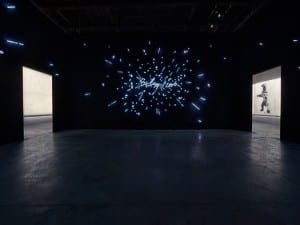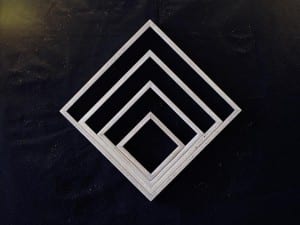Swatch has a long history of collaborating with artists. From its first design collaboration with Kiki Picasso in 1984 to its ongoing relationship with the Venice Biennale, the company is at the forefront of nurturing artists’ practice and exposing their works to a wider audience. The Swatch Faces 2015 exhibit at the 56th Venice Biennale continues this tradition, showcasing works from previous residents of the Shanghai Swatch Art Peace Hotel including Alec von Bargen, Yan Wang Preston, Chiara Luzzana and Luca Bray.
Opened in 2012, the Swatch Art Peace Hotel provides accommodation, studio space and opportunities for artists to realise their plans while opening up a dialogue with the city and collaborations with other resident artists. While Venice’s Swatch Faces2015 exhibit only shows a small snapshot of the output of this venture the recurring theme in these artists’ works seems to be a reconsideration of space and place and its implications upon people for their cultures and identities.
Through sound installations that capture its vibrancy but also attempt to reach out to the quieter moments of the city, Italian artist Chiara Luzzana’s The 8 Soundtracks of Shanghai provides the soundtrack to the exhibition space. A combination of found and orchestrated sounds, Luzzana’s work shows the sensory overload of this truly unique city, while taking its atmosphere to the point of abstraction.
Alec von Bargen, who has exhibited at the Aesthetica Art Prize, was resident at the hotel from April to October 2013 and his work at Venice, Man, Forgotten is more introspective than his previous photography and posits the artist within the human need to belong and the search for association with a space. The notion of place and cultural immersion lies at the heart of von Bargen’s work. The American photographer, who grew up in England and Mexico, concentrates on assimilating himself within a culture because the notion of place and how people identify themselves as a group and as against other groups is central to how his photographs pan out. Having created photo projects across the rivers of Asia and from African refugee camps to the immigration routes into Europe, it is this initial settling into his environs that is just as important to von Bargen as his final photographic output and one reason why the residency appealed.
Projects such as Crash-ed; Everyone is Gone, created in Iceland immediately after the financial crisis of 2008, emphasise the ability of art and life to take even the artist by surprise in its new, inconceivable directions. Visiting Iceland at one of its most difficult moments in modern history von Bargen discovered a proud, almost quietly embarrassed population that was struggling silently to come to terms with the implications of their unexpected financial disaster. Because the people of Iceland had enjoyed a long period of prosperity and pride in the success of their country and their economy, and because no-one expected it to implode in the manner in which it did, von Bargen entered the country expecting a cathartic process but found himself, particularly as an outsider, shut out from the country’s own attempts to come to terms with its situation and witnessed a landscape and social fabric that was being isolated and abandoned by its people. Rather than a mediation on Iceland’s unique people and landscape what followed was a process of re-discovery of itself through an outsider’s eyes and an interrogation of its residents’ new place in the world in relation to the fallout of recent events.
Chinese-born British artist Yan Wang Preston’s Mother River takes the myth of place and its representations in the history of the Chinese people as a starting point for her project that led to her photographing 100km intervals along the Yangtze River. This river is of immense cultural importance to the Chinese people but what Yan discovered was that the pure, mystical river of popular belief held little correlation with reality. By dogmatically taking her pictures at regimented intervals regardless of the beauty, or lack thereof, in front of her lens, Yan opens an interrogation of the state of modern China today at the crossroads at which the country finds itself between modernity and tradition. The austere beauty and purity of the river’s source stands in stark contrast to its later, chaotic, more urbanised iterations and, while the project implicitly raises questions of the environmental responsibilities of the country’s rapid industrialisation, Yan insists that there was no motivation to create this message in her work. Inadvertently however the powerful contrasts highlighted by Mother River show a country at risk and in flux.
Yan finalised the project during her residency at the Swatch Art Peace Hotel and as a previous resident of Shanghai, the dramatic transformations of the city were immediately apparent. In fact, given China’s continued oppression of free expression, Swatch’s decision to locate a space dedicated to artistic development is an unusual one and Swatch Creative Director, Carlo Giordanetti, acknowledges that there has been a very small number issues where the company and its artists have removed certain works to avoid offence to the Chinese government. But while this creates an uncomfortable threat to the creative freedoms that European companies such as Swatch want to encourage through their corporate sponsorship, the location of the hotel in Shanghai is symptomatic of the country’s increased openness and engagement with the arts. Giordanetti tells of a popular type of guerrilla art rearing its head all over the country in the form of water paintings – where protestors will paint controversial slogans on pavements in water, for them to simply evaporate before repercussions are felt. The clear desire for dissidence and very real risks of this action highlight why art still has such a key role in democracies and oppressive states alike and further emphasises the huge importance of space on art-making even in this globalised age.
The Swatch Faces 2015 exhibition will show throughout the Venice Biennale. In addition Swatch is celebrating its latest Art Specials from Eva & Adele (who are also represented at the Arsenale) and Joana Vasconcelos (who has presented the Garden of Eden Swatch Pavillion at the Giardini).
Swatch Faces 2015, until 22 November at Venice Biennale. Find out more at http://tinyurl.com/pk3wwmo.
Ruby Beesley
Credits
1. Swatch Faces 2015 Pavilion at Giardini, courtesy of Swatch.





